This is a short walk that you can do directly from your holiday cottage at Kirkennan in less than an hour. These photos were mainly taken from a walk around it in late April when the wild flowers were the star of the show...
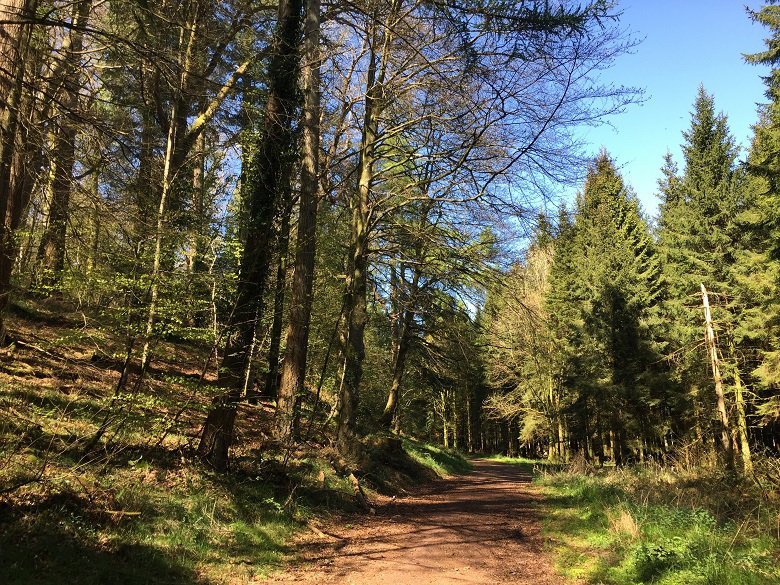
Kirkennan woods lie the opposite side of the public road to Kirkennan Estate. They used to belong to the Estate but were sold seperately when we purchased Kirkennan in 2013. There are a number of paths open to the public running through the woodland and it is a lovely and quiet place to walk; I rarely meet anyone else there. This particular walk is a short loop of less than an hour designed to take in a view point and to go past the ruins of Kirkennan's old walled garden.
To do this walk leave Kirkennan Estate by the north gate (the one nearest the stable block), after exiting walk along the road to your left for about 20m and enter Kirkennan Woods via the signpost gate on the opposite side of the road. Once in the woods take the flat path straight ahead.

In late April this stretch had carpets of flowering wood sorrel (Oxalis acetosella) under the trees to the right. Wood sorrel is a good indication of ancient woodlands. It favours damp shady places near streams. You can identify it by its slighly hairy trefoil leaves and five petalled white flowers with purple veins. Both of these fold up at night and sometimes on an overcast day. It blooms around Easter time which has led to it sometimes being called 'Alleluia'. Other common names include 'Fairy Bells', 'Wood Sour' or 'Cuckoo’s Meat'. The word sorrel come from the same root as 'sour' caused by the oxalic acid the plant contains. Some books list it as toxic, others as a desirable wild food. For more information see the Wild Food Directory at Original Outdoors.
The video clip below shows these delicate blooms dancing in a light breeze whilst the birds sing in the background.
The next flower I came across took me a while to identify. It was only when I went back to look at the back of the flower that I could be certain that it is a Red Campion (Silene dioica) with rather more indented petals than normal. Red Campion plants are either male or female (the technical term is dioecious); the photo shows a female plant which has flowers with long styles. Red Campion is again an indicator of ancient woodland. It likes to grow in lightly shaded areas and can also be frequently found on roadside verges. It is a good source of food for bees, butterflies, moths and hoverflies.
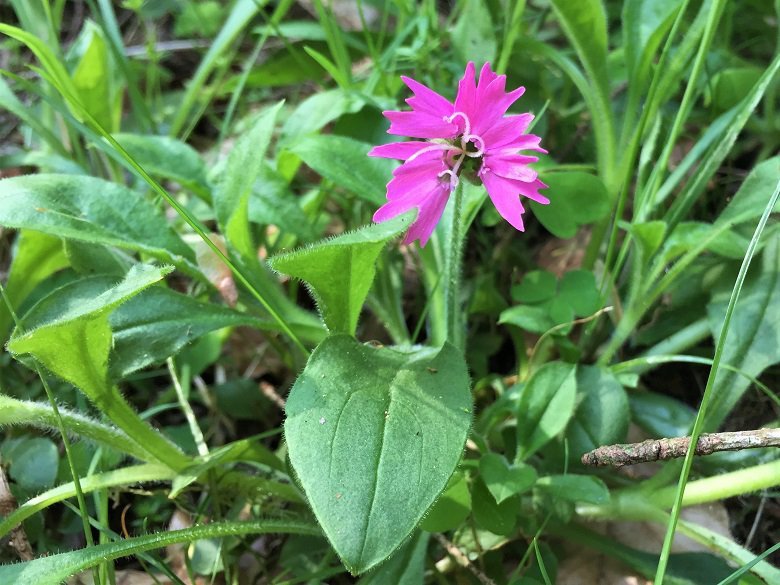
Such a pretty flower actually gets its latin name from rather an unpleasant linkage - it is named after the Greek woodland God, Silenus, who was said to be frequently drunk and covered in a sticky foam (his name comes from the Greek word for saliva - sialon which gives some indication of what the foam might have been). Female Red Campion flowers apparently also produce a froth or foam that helps to catch pollen from visiting insects, though it isn't apparent on this flower.
Also along this stretch of path I found wild primroses, (Primula Vulgaris). Primroses are small perennial woodland plants that can flower from December to May. They are an important nectar source for butterflies such as small tortoiseshell and brimstone (a butterfly that is common in England and Wales with a range that is slowly expanding northwards - I have yet to see a brimstone butterfly at Kirkennan). In folklore Primroses are meant to symbolise eternal love. Like wood sorrel and red campion they are an indicator of ancient woodland.
The name comes from the Latin prima rosa, literally 'first rose'. Though it is not related to the rose it is an early decorative flower.
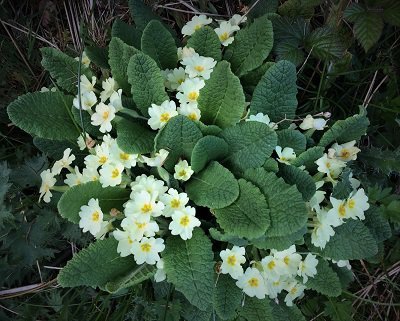
Wood anemone (Anemone nemorosa) is another delicate white flower that again is an indication of ancient woodlands. It has white 'petals' which sometimes have a pink or purple tinge (they are actually sepals) and numerous distinct yellow anthers. Hoverflies are said to visit these flowers and play a role in its pollination, though the seeds tend to be infertile so they spread slowly via underground rhizomes.
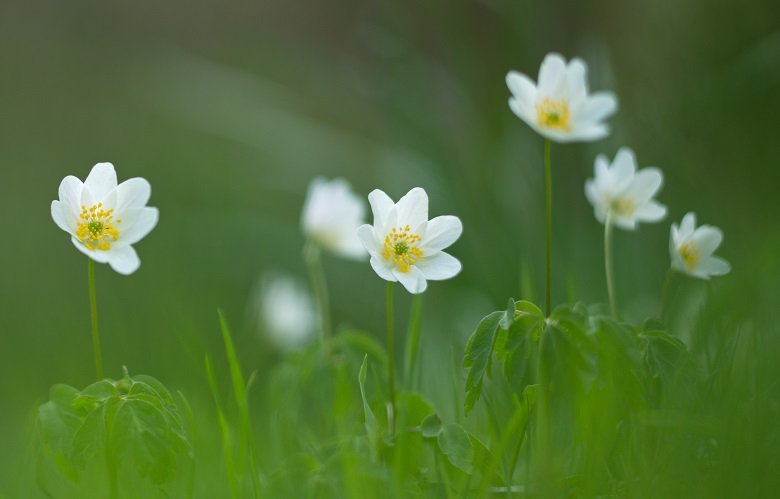
The Wood anemone is often called 'windflower', possibly because they shimmer in the breeze. They are named after the Greek god, Anemos, who was god of the wind and was said to send anemones in early spring to herald his coming. The Romans used to wear the first flowers of the wood anenome as a lucky charm to protect against fever.

Common Dog Violet (Viola riviniana) is the most familiar wild violet and flowers from April till June; most of the wild violets you see are likely to be this form. It has no scent, which is how you can distinguish it from the Sweet Violet. Indeed the prefix 'dog' refers to its lack of scent - indicating its inferior status to the 'sweet' violet.
Its leaves are dark green and heart shaped.
Various fritillary butterflies lay their eggs on these plants including the Dark Green and the Small pearl-bordered which can both be found in this area of Scotland, though I have yet to knowingly see one.
Common names include 'snake violet', 'horse violet', 'pig violet', 'blue mice', 'shoes and stockings' and 'cuckoo's shoe'. None of these sound very romantic, but in Victorian times sending a purple violet indicated that you were 'occupied with love' for the recipient. Similarly Ancient Greeks considered the violet to be a symbol of romance and fertility.
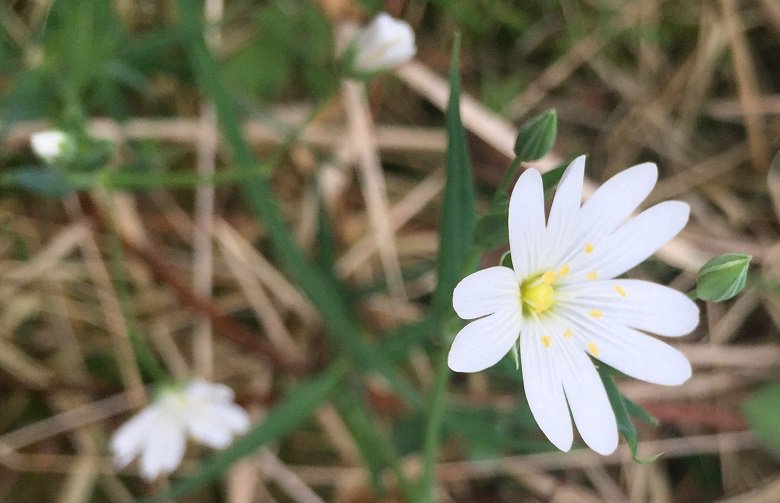
Greater Stitchwort (Stellaria holostea) is another common flower of woodlands to be found April - June. It can be identified by its five white petals with such deep indentations that they are almost divided in two. It is similar to the Lesser Stitchwort but has larger flowers (2-3cm as compared to 0.5-1cm across). When the seed pods ripen in late Spring they explode to spread their seeds and can be heard popping if you listen carefully.
It provides spring nectar to hoverflies, butterflies and hopefully also Kirkennan's honey bees. It is also a food plant for Large Yellow Underwing and Plain Clay Moths.
In the past Greater Stitchwort was used as a remedy for stitch, this being the root of the name 'stitchwort'. It has many common names, including, 'Snapdragon' which gives another indication on how to identify it - its square stems are brittle and easily break. It is also called 'Star-of-Bethlehem', 'wedding cakes' and 'daddy's-shirt-buttons' or 'poor man's button hole' presumably because it was worn as a buttonhole decoration for weddings and other festive occassions. However given that picking them is said by some to cause thunderstorms or to anger pixies this seems like a risky way to prepare for the celebration.
Lesser Celandine (Ficaria verna ), like many wildflowers, is often considered to be a weed as it spreads readily in the garden. There is certainly a lot in the walled garden at Kirkennan, though I quite like its cheerful yellow flowers. However this is the first time I have seen a 'double' Lesser Celandine, a mutation that makes the flower have many additional petals.
The Lesser Celandine flowers between January and April and, being one of the earliest wild flowers to bloom, is an important source of early pollen and nectar for insects, in particular early emerging ones such as queen bumblebees - though non mutated flowers are usually better for this (which is why we try to plant single rather than double varieties in Kirkennan's garden).
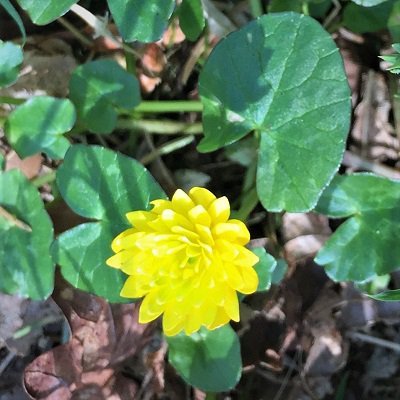
The name Celandine comes from the Greek chelidon meaning 'swallow' (the bird not the action), this is thought to be because the appearance of either the bird or the flower was deemed to announce the start of Spring. It is sometimes called 'Spring Messenger' and the Victorians used it to symbolise 'joys to come'.
A less attractive name is 'pilewort' coming from its use in treating haemorrhoids; as this was based purely on the knobbly shape of the tubers (thought to resemble piles) I doubt it met with much success. A more successful use was probably in the prevention of scurvy as the leaves do contain significant amounts of Vitamin C.
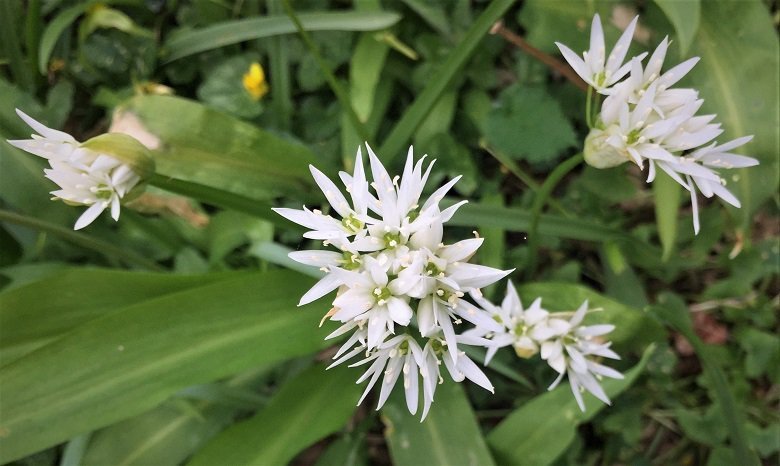
Wild Garlic (Allium ursinum) and bluebells (Hyacinthoides non-scripta) are also currently blooming in Kirkennan Woods along with their distinctive but very different scents. I have written about Wild Garlic and bluebells in previous blogs so wont repeat it here.
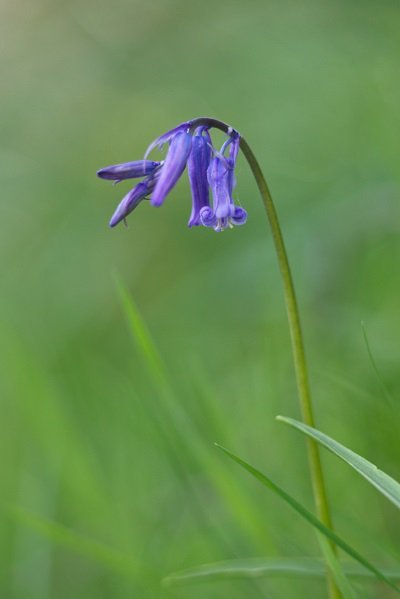
It is probably time to get back to the route I took. A quick recap - after entering through the gate I took the level path straight ahead ignoring the rising path to the left. I then took the second turning to the left, which again was uphill. This will come to a junction where you should again turn left. Here the path levels off for a bit.
It is worthwile pausing at this point to take in the view towards Dalbeattie Forests and the hills behind them.

After about 5 - 10 minutes the ground starts to dip. Going straight on will take you back to the entrance where you started.
I took the turn to the right (see photo). This leads uphill and then the main path starts to bend to the right just as I took a much grassier track to the left. This grassy path starts to go downhill and then takes an almost right hand bend to the right. At this point look out for the ruins of the previous walled garden for Kirkennan House which can be seen to your left.
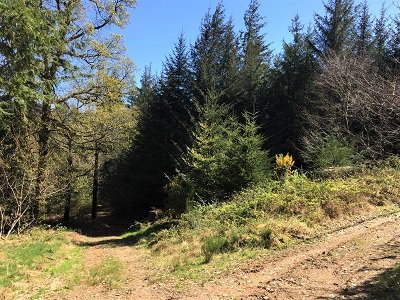
The stone walls of the old walled garden are now rather derelict and the area is so overgrown with trees that it is hard to imagine it ever being a productive space. At one time there was a bridge over the road connecting it with the main Estate gardens.
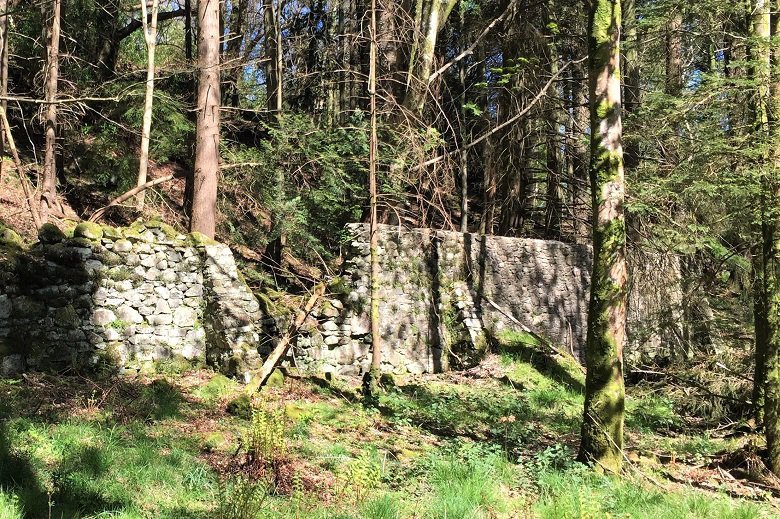
After you have finished exploring the ruins you can continue along the track which now runs parallel to the road for a while. You can glimpse the greenhouse in Kirkennan's new walled garden through the trees. This area again has bluebells in late April, to early May. The path then rises for for a few meters before dropping to leave Kirkennan woods near Kirkennan Cottage. If you are staying at Kirkennan you can turn left and walk along the road for a few minutes before entering the Estate near Kirkennan Lodge. Other readers should either walk back along the road, or retrace their steps taking a right turn each time there is a choice and they will find themselves back at the entrance where they started.
Practical Details
This is a short easy walk that takes around 40 minutes from the door of any of the 3 cottages at Kirkennan Estate (depending on how long you spend looking at flowers). If the weather has been dry the initial level path should be accessible with a wheelchair or pushchair, the other paths are too steep and eneven in places to make access easy. If it has been raining a lot, or if the logging trucks have been active, all the paths may be too muddy. The walk is suitable for dogs who can normally be let off the lead (note there are sometimes restrictions when logging is taking place). There is a gate by the initial entrance to the woodland but the path at the end of this route goes straight onto the road so be aware if dogs or young children are running ahead.
About the author
My husband and I moved to Kirkennan Estate in 2013 where we established a family run business with 3 holiday cottages and where we grow most of our own fruit and vegetables. This blog was written during April 2020 whilst the whole country is locked down due to the Covid19 Pandemic; hence the focus on a walk that can be done from the door. We look forward to when we can re-open our cottages and again welcome nature lovers and walkers to a stunning part of Scotland. Feel free to contact me if you would like more information about any of our cottages, Kirkennan or the local area.
Jenny Chapman, April 2020
The Mews
The Mews is a cozy 2 bedroomed cottage that used to be the Estate Office for Kirkennan. It has a king sized double bed and a twin room that can be made up as a triple room. It features a wood burning stove and great views over Kirkennan's landscaped gardens.
Woodsedge
Woodsedge is a 3 bedroom cottage all on one level. It has a standard double, a twin and a single bedroom. It features a wetroom and a woodburning stove as well as a private rear garden. It looks out across fields and woodland.
The Lodge
The Lodge is a 4 bedroom detached cottage that stands on its own in a large garden by the southern gate to the Estate. It has a king sized double and a twin bedroom on the ground floor and a single with an attic bedroom reached through it which can be single or twin.




